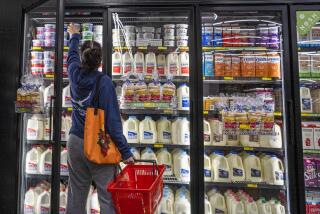3-Year Inflation Rate Is Lowest in Two Decades
- Share via
WASHINGTON — Prices at the wholesale level inched up a modest 1.8% in 1985, producing the lowest three-year inflation rate in two decades, the government said Friday.
Economists said the year-end figures point to another year of relatively low inflation for 1986. Wholesale prices rose 0.6% in 1983 and 1.7% in 1984.
The Labor Department said wholesale prices rose only 0.4% in December, moderating from the 0.8% increase of the month before. Analysts credited the lower December rate to a slowing in food and energy price increases.
Food prices rose 0.3% for the year, after a 3.5% rise in 1984, while energy prices generally showed no annual change.
Beef Prices Rose
A large part of the year’s food price increase was an overall 12.3% boost in the cost of vegetables and a surge in beef prices in the fall that has since ended. Food prices actually dropped six months out of the year.
Beef prices, which had climbed 11.8% in October and 4.5% in November, fell 0.7% in December.
For December alone, overall food prices were up 0.8%, after a 1.6% jump in November.
Gasoline prices were up 3% for the year. For December, the increase was 2.8%, compared to a 3.7% increase in November.
Lower Fuel Costs
Analysts said they anticipate that falling crude oil prices--resulting from the chaotic meeting last month of the Organization of Petroleum Exporting Countries--will show up in significantly lower gasoline and other fuel costs in the months to come.
Labor Department economist Craig Howells said the slight increase in gasoline prices posted in December--a month when these prices typically declined--occurred because refiners were using up their inventories and holding off on new crude oil purchases in anticipation of much lower prices.
This led to spot shortages and spot increases, Howells said.
Crude oil prices themselves fell 4% for all of 1985.
Offsetting Gains
Department analysts noted that, if the effects of food and energy prices were removed from the overall calculation, wholesale prices would have held steady for December, with declines in the costs of cars and prescription drugs offsetting gains in prices for clothing, tobacco, cosmetics, costume jewelry and light trucks.
At the White House, presidential spokesman Larry Speakes called the wholesale price report “a remarkable record of low inflation.”
Private economists generally agreed that the report points toward continued low inflation, with 1986 producer prices creeping up just a tad more than they did through 1985.
“The turmoil that exists in the world market for crude oil and all the weaknesses that it is beginning to show will ultimately impact on domestic prices, bringing them down,” said Frantz Price, an economist for Chase Econometrics, a Bala-Cynwyd, Pa., forecasting firm.
Not Much Impact
He said the declining dollar on international markets has not yet made much of an impact on U.S. wholesale prices, judging from the December figures.
“In 1986, we may see limited acceleration in inflation but nothing to worry about,” said Price. “The decline in the dollar will have an impact, but not a major one.”
Michael Evans, who runs his own economic forecasting service in Washington, also said there is no indication that a continued slide in the value of the dollar--which would generally help make U.S. products more competitive abroad--is going to result in dramatically higher prices here for imports.
“The dollar might add a half a percent to inflation next year, but that’s an outside estimate. I don’t think it will be that high,” Evans said.
December Specifics
The Labor Department offered these specifics on December wholesale price activity:
--Fish prices increased 1.9%, poultry prices dropped 0.5% and pork prices dropped 1.1%.
--Coffee prices rose 3.3%, largely because of a Brazilian drought. Bakery products increased 0.4%, alcoholic beverages stayed the same and soft-drink prices dropped 0.5%.
--Prices for women’s apparel increased 0.8%, while men’s and boys’ clothes went up only 0.3%. Girls’ and infants’ apparel rose 1.3%.
--Natural gas prices dropped 1.7%, the third straight monthly decline. Fuel oil prices rose 1.5%.
Inflation at the retail level increased at an annual rate of 3.6% throughout the first 11 months of 1985, compared to a 4% increase for all of 1984.
The overall producer price index for finished goods stood at 297.2 in December, meaning that goods costing $10 in 1967 would have cost $29.72 last month.
More to Read
Inside the business of entertainment
The Wide Shot brings you news, analysis and insights on everything from streaming wars to production — and what it all means for the future.
You may occasionally receive promotional content from the Los Angeles Times.









